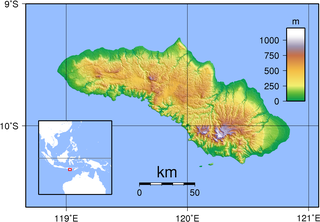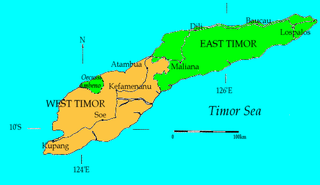
Sumba, natively also spelt as Humba, Hubba, Suba, or Zuba is an Indonesian island located in the Eastern Indonesia and administratively part of the East Nusa Tenggara provincial territory. Sumba has an area of 11,243.78 square kilometres, about the same size as Jamaica or Hawaii (Island). The population was 686,113 at the 2010 Census and 779,049 at the 2020 Census; the official estimate as of mid-2023 was 820,506. To the northwest of Sumba is Sumbawa, to the northeast, across the Sumba Strait, is Flores, to the east, across the Savu Sea, is Timor, and to the south, across part of the Indian Ocean, is Australia.

Timor is an island at the southern end of Maritime Southeast Asia, in the north of the Timor Sea. The island is divided between the sovereign states of East Timor in the eastern part and Indonesia in the western part. The Indonesian part, known as West Timor, constitutes part of the province of East Nusa Tenggara. Within West Timor lies an exclave of East Timor called Oecusse District. The island covers an area of 30,777 square kilometres. The name is a variant of timur, Malay for "east"; it is so called because it lies at the eastern end of the Lesser Sunda Islands. Mainland Australia is less than 500 km away, separated by the Timor Sea.

West Timor is an area covering the western part of the island of Timor, except for the district of Oecussi-Ambeno. Administratively, West Timor is part of East Nusa Tenggara Province, Indonesia. The capital as well as its main port is Kupang. During the colonial period, the area was named Dutch Timor and was a centre of Dutch loyalists during the Indonesian National Revolution (1945–1949). From 1949 to 1975 it was named Indonesian Timor.

East Nusa Tenggara is the southernmost province of Indonesia. It comprises the eastern portion of the Lesser Sunda Islands, facing the Indian Ocean in the south and the Flores Sea in the north. It consists of more than 500 islands, with the largest ones being Sumba, Flores, and the western part of Timor; the latter shares a land border with the separate nation of East Timor. The province is subdivided into twenty-one regencies and the regency-level city of Kupang, which is the capital and largest city.

The Savu Sea is a small sea within Indonesia named for the island of Savu (Sawu) on its southern boundary. It is bounded by Savu and Raijua to the south, the islands of Rote and Timor to the east, Flores and the Alor archipelago to the north/northwest, and the island of Sumba to the west/northwest. Between these islands, it flows into the Indian Ocean to the south and west, the Flores Sea to the north, and the Banda Sea to the northeast.

Rote Island is an island of Indonesia, part of the East Nusa Tenggara province of the Lesser Sunda Islands. According to legend, this island got its name accidentally when a lost Portuguese sailor arrived and asked a farmer where he was. The surprised farmer, who could not speak Portuguese, introduced himself, "Rote".

Waingapu is the largest town in the eastern half of Sumba island, East Nusa Tenggara, Indonesia. It is the capital town of the East Sumba Regency.
The Sumba–Hawu languages are a group of closely related Austronesian languages, spoken in East Nusa Tenggara, Indonesia.
The Sumba–Flores languages, which correspond to the traditional "Bima–Sumba" subgroup minus Bima, are a proposed group of Austronesian languages spoken on and around the islands of Sumba and western–central Flores in the Lesser Sundas, Indonesia. The main languages are Manggarai, which has half a million speakers on the western third of Flores, and Kambera, with a quarter million speakers on the eastern half of Sumba Island.

Kupang Regency is a regency in East Nusa Tenggara province of Indonesia. It occupies the far western end of Timor Island, together with the smaller island of Semau and other minor offshore islands. Other islands further to the southwest and west which were formerly part of Kupang Regency have been separated administratively - the Rote Islands Group on 10 April 2002, and the Savu Islands Group on 29 October 2008.

Sabu Raijua Regency is one of the regencies in the province of East Nusa Tenggara, Indonesia. This regency has an area of 477.40 km2 which includes two main islands in the Sawu Sea, namely Sabu Island and Raijua Island, plus uninhabited Rai Dana Island. Sabu Island is the largest and is the center of government with its capital in West Sabu district, while Raijua Island is smaller and located to the west of Sabu Island. The regency was established by Indonesia's Minister of Home Affairs, Mardiyanto, on 29 October 2008, when it was partitioned from Kupang Regency. The population was 72,960 at the 2010 census, and 89,327 at the 2020 Census; the official estimate as at mid 2023 was 93,323.

The Savunesepeople, also known as orangSabu or Sawu or douHawu, are the people of Savu and smaller neighbouring Raijua in East Nusa Tenggara, Indonesia.
Savu is an island in East Nusa Tenggara province, Indonesia.

The Hawu language is the language of the Savu people of Savu Island in Indonesia and of Raijua Island off the western tip of Savu. Hawu has been referred to by a variety of names such as Havu, Savu, Sabu, Sawu, and is known to outsiders as Savu or Sabu. Hawu belongs to the Malayo-Polynesian branch of the Austronesian language family, and is most closely related to Dhao and the languages of Sumba. Dhao was once considered a dialect of Hawu, but the two languages are not mutually intelligible.

The Savu languages, Hawu and Dhao, are spoken on Savu and Ndao Islands in East Nusa Tenggara, Indonesia.
Tardamu Airport is located in Sabu Island, Sabu Raijua Regency, East Nusa Tenggara, Indonesia. Due to the short runway, it is only served by Cessna 264: Caravan jetprop aircraft operated by Susi Air up to twice per day from Kupang, up to five times per week from Waingapu and up to five times per week from Ende.

The Sumba people are an ethnic group inhabiting Sumba Island in Indonesia, which is divided by four regencies, namely the Southwest Sumba Regency, West Sumba Regency, Central Sumba Regency, and the East Sumba Regency. They refer to themselves as Tau Humba. The Sumbese have been able to retain much of their culture despite foreign influences that arrived long ago on the Lesser Sunda Islands.
The Kambaniru River is a river in the island of Sumba, Indonesia, about 1,500 km east of the capital Jakarta. With a length of approximately 118 km, it flows periodically through 9 districts in the East Sumba Regency, exiting to the Bay of Kambaniru near the city of Waingapu to the Sawu Sea, with high debit in the wet season, but very low in the dry season.
David Constantijn Saudale Airport, formerly known as Lekunik Airport, is an airport in Rote Ndao Regency, East Nusa Tenggara, Indonesia. It serves Ba'a, the capital city of Rote Ndao Regency as well as the largest town in Rote Island. The airport serves as one of the main points of entry to Rote Island. The airport has a runway length of 1650 m × 30 m with a taxiway of 75 m × 17 m and aprons measuring 120 m × 85 m. The airport can only accommodate small aircraft such as the ATR-72. It has a 1,170 square meter passenger terminal and an operational building consisting of office buildings, NDB flight navigation building, workshop building, ATC tower, PKP-PK building and PH building. Wings Air is currently the only airline serving the airport, operating two daily flights to and from Kupang.
Cornelis Feoh was an Indonesian politician and member of the Golkar Party of East Nusa Tenggara. Feoh, who was from Rote Island in Rote Ndao Regency, served in the East Nusa Tenggara Regional People's Representative Council (DPRD) from 2019 until his death in office on January 3, 2021.















